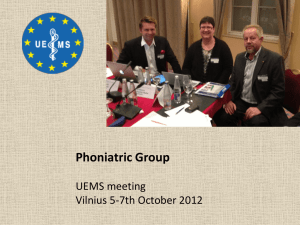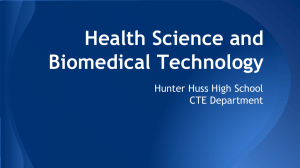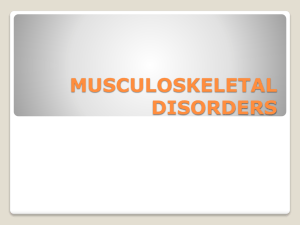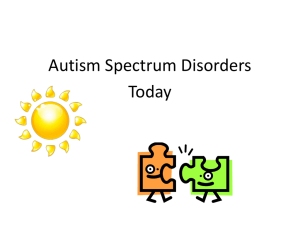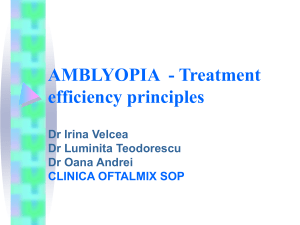Eyes and Vision
advertisement
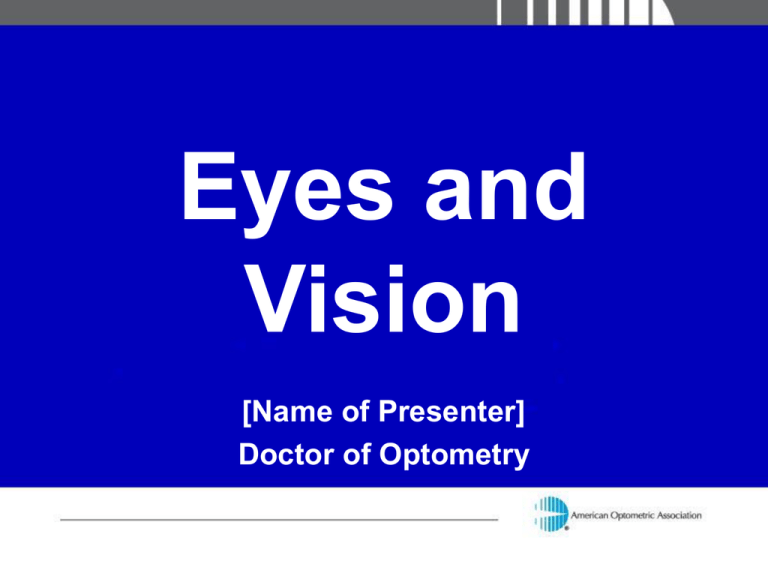
Eyes and Vision [Name of Presenter] Doctor of Optometry Presentation provided by: Scott A. Jens, O.D. AOA Member Madison, WI The Amazing Eye The process of vision An object in the world is seen by the eye upside down The brain processes the eye’s image to create the picture of the object ANDY ANDY Brain ANDY When vision is bad... The cornea and lens need to focus light onto the retina for clear vision Often, the focus is not sharp... Hyperopia (farsightedness) Myopia (nearsightedness) Astigmatism Incidence of eye disorders, age 6 mos. to 18 yrs. Hyperopia (farsightedness) 25% Astigmatism 23% Myopia (nearsightedness) 18% Non-strabismic binocular disorders 14% Strabismus 12% Amblyopia 7% Accommodative disorders 6% Peripheral retinal abnormalities, 2% requiring referral or follow-up Hyperopia (farsightedness) Too little focusing power causes light to be focused “behind” the retina Convex lenses focus light onto the retina A significant cause of learning problems, as it often goes undetected by school or pediatrician screenings Common cause of reading glasses Incidence of eye disorders, age 6 mos. to 18 yrs. Hyperopia (farsightedness) Astigmatism Myopia (nearsightedness) Non-strabismic binocular disorders Strabismus Amblyopia Accommodative disorders Peripheral retinal abnormalities, requiring referral or follow-up 25% 23% 18% 14% 12% 7% 6% 2% Astigmatism The cornea/lens optical system is different in the horizontal and vertical focal planes Found in combination with farsightedness and nearsightedness Results in blur at distance and near Compound-grind lenses focus light onto the retina Incidence of eye disorders, age 6 mos. to 18 yrs. Hyperopia (farsightedness) Astigmatism Myopia (nearsightedness) Non-strabismic binocular disorders Strabismus Amblyopia Accommodative disorders Peripheral retinal abnormalities, requiring referral or follow-up 25% 23% 18% 14% 12% 7% 6% 2% Myopia (nearsightedness) Too much focusing power causes light to be focused “in front” of the retina Concave lenses focus light onto the retina Early onset occurs between 2nd and 5th grades, onset most common between grades 6th and 10th Many control methods examined, and none work! Incidence of eye disorders, age 6 mos. to 18 yrs. Hyperopia (farsightedness) Astigmatism Myopia (nearsightedness) Non-strabismic binocular disorders Strabismus Amblyopia Accommodative disorders Peripheral retinal abnormalities, requiring referral or follow-up 25% 23% 18% 14% 12% 7% 6% 2% Non-strabismic binocular disorders The “binocular” system of humans depends on vision from each eye that is equally clear and overlapped into one image instead of double Eye aiming can be miscoordinated Many learning difficulties can result from the eyes not easily aiming at the same point -the more the effort, the more the fatigue, etc. Incidence of eye disorders, age 6 mos. to 18 yrs. Hyperopia (farsightedness) Astigmatism Myopia (nearsightedness) Non-strabismic binocular disorders Strabismus Amblyopia Accommodative disorders Peripheral retinal abnormalities, requiring referral or follow-up 25% 23% 18% 14% 12% 7% 6% 2% Strabismus “Eye turn” Crossed eye, esotropia Wandering eye, exotropia Double vision is uncommon because of brain adaptation called suppression Treatments include: proper prescription, patch to equalize the individual eyes’ abilities, and surgery by age 2 for greatest chance at a functional cure Incidence of eye disorders, age 6 mos. to 18 yrs. Hyperopia (farsightedness) 25% Astigmatism 23% Myopia (nearsightedness) 18% Non-strabismic binocular disorders 14% Strabismus 12% Amblyopia 7% Accommodative disorders 6% Peripheral retinal abnormalities, 2% requiring referral or follow-up Amblyopia Phrase “lazy eye” is often used to describe amblyopia Permanent reduction of an eye’s best sharpness, even with glasses, that results from the brain constantly ignoring the image of an eye that is crossed or from an eye that is significantly different in prescription than the other eye Incidence of eye disorders, age 6 mos. to 18 yrs. Hyperopia (farsightedness) 25% Astigmatism 23% Myopia (nearsightedness) 18% Non-strabismic binocular disorders 14% Strabismus 12% Amblyopia 7% Accommodative disorders 6% Peripheral retinal abnormalities, 2% requiring referral or follow-up Accommodative disorders Accommodation = ability to “zoom” focus on near objects Problems can include insufficient amount of focus, overly active focus, lock of focus, and slowly shifting focus The muscle that controls focus can be trained to work more efficiently Bifocals can be used for children Incidence of eye disorders, age 6 mos. to 18 yrs. Hyperopia (farsightedness) Astigmatism Myopia (nearsightedness) Non-strabismic binocular disorders Strabismus Amblyopia Accommodative disorders Peripheral retinal abnormalities, requiring referral or follow-up 25% 23% 18% 14% 12% 7% 6% 2% Peripheral retinal abnormalities Dilated eye examinations are periodically required to evaluate parts of the inner eye that can show abnormality Examples include retinal degenerations, retinal detachments, and retinal tumors. Inside the numbers... 26% of US population is less than 18 years of age 31% of those 6 to 16 years old had an eye and vision examination within the past year 14% of those less than 6 years old had an eye and vision examination within the past year Vision checkups and screenings Many people benefit from having their eyes tested with an eye chart to see if they see properly -- called a “screening” Vision screening is never a replacement for a comprehensive eye examination Screenings check for vision blurriness Exams evaluate vision blurriness, PLUS eye muscle teaming, focus ability, and eye health Why so few eye exams? Parent reliance on vision screenings, provided by pediatrician or school Cost to uninsured families Lack of good public information as to the importance of periodic eye care Unable to pay for professional care? NOTE: Due to differences in state, province, and region free services, add info applicable to audience, or remove slide from presentation if services are unavailable. The Role of Vision in Learning The eyes must see clearly, without double vision, and with accurate depth of focus control A child must have the visual ability to learn to read prior to reading to learn When a child cannot learn, think first of their ability to see, then of their ability to learn Comprehensive Eye Exams Optometrists and ophthalmologists are eye doctors who provide eye examinations Are easy and painless! Can find the problems that relate to poor learning Here is a “peek”... Color Vision Depth Perception Keratometry Visual Acuity Refraction Eye Health Test Eye Pressure Eye Drops -- Dilating the Pupil Eye Health Tests The “Headlight” Health Exam Tests for Babies and Young Children, too! Questions?? Thank you!!


